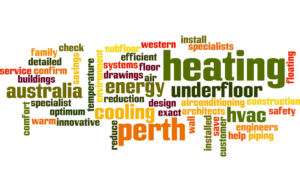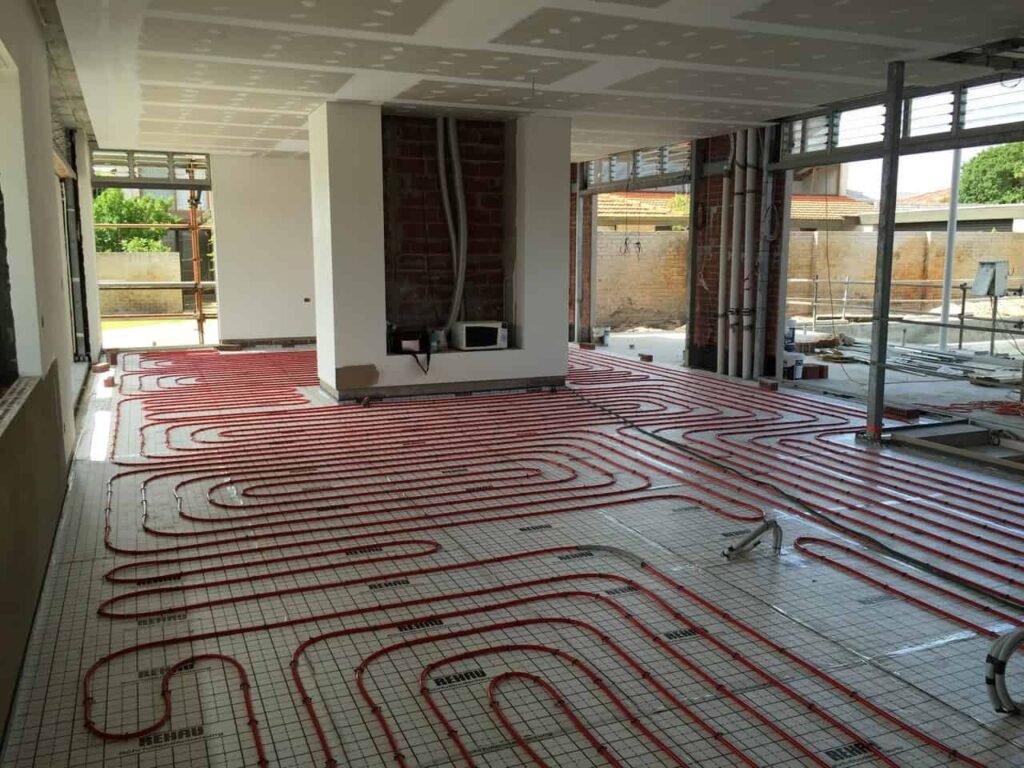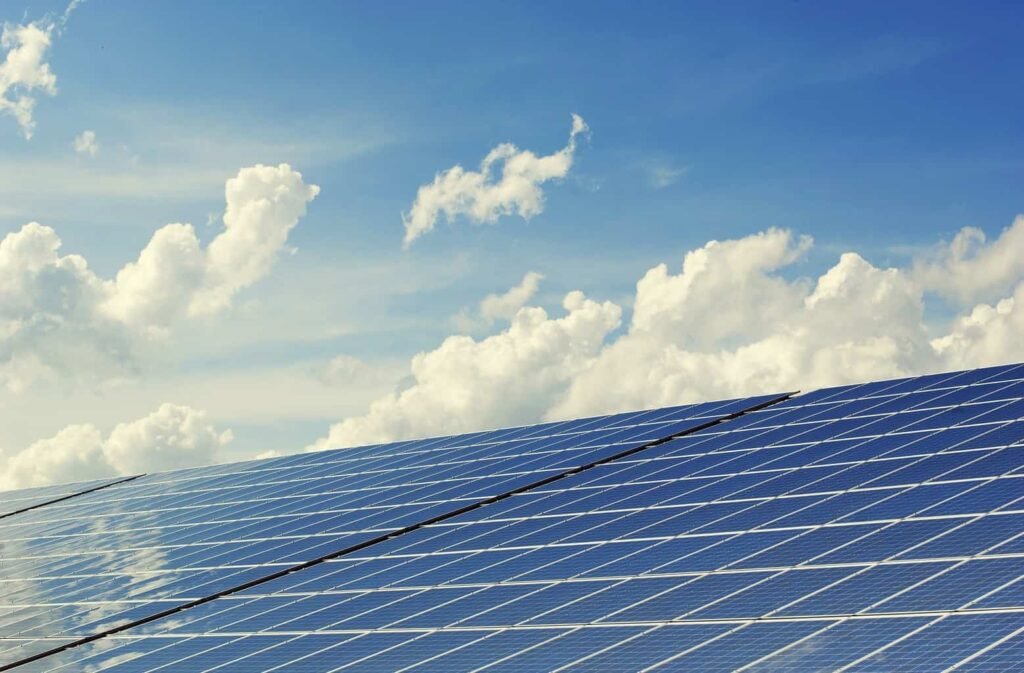Thermal comfort quality
Thermal comfort is, “that condition of mind which expresses satisfaction with the thermal environment and is assessed by subjective evaluation.” (As defined by ANSI/ASHRAE Standard 55 – Thermal Environmental Conditions for Human Occupancy)
Relating specifically to floor heating, thermal comfort is influenced by floor surface temperature and associated elements such as radiant asymmetry, mean radiant temperature and operative temperature.
Research by Nevins, Rohles, Gagge, P. Ole Fanger et al. show that humans at rest with clothing typical of light office and home wear, exchange over 50% of their sensible heat via radiation.
Floor heating influences the radiant exchange by thermally conditioning the interior surfaces with low temperature long wave radiation. The heating of the surfaces suppresses body heat loss resulting in a perception of heating comfort.
This general sensation of comfort is further enhanced through conduction (feet on floor) and through convection by the surface’s influence on air density. floor cooling works by absorbing both short wave and long wave radiation resulting in cool interior surfaces. These cool surfaces encourage the loss of body heat resulting in a perception of cooling comfort.
Localized discomfort due to cold and warm floors wearing normal foot wear and stocking feet is addressed in the ISO 7730 and ASHRAE 55 standards and ASHRAE Fundamentals Handbooks and can be corrected or regulated with floor heating and cooling systems.
Indoor air quality
Floor heating can have a positive effect on the quality of indoor air by facilitating the choice of otherwise perceived cold flooring materials such as tile, slate, terrazzo and concrete. These masonry surfaces typically have very low VOC emissions (volatile organic compounds) in comparison to other flooring options. In conjunction with moisture control, floor heating also establishes temperature conditions that are less favorable in supporting mold, bacteria, viruses and dust mites.
By removing the sensible heating load from the total HVAC (Heating, Ventilating, and Air Conditioning) load, ventilation, filtration and dehumidification of incoming air can be accomplished with dedicated outdoor air systems having less volumetric turnover to mitigate distribution of airborne contaminates. There is recognition from the medical community relating to the benefits of floor heating especially as it relates to allergens.
Energy
Floor radiant systems are evaluated for sustainability through the principles of efficiency, entropy, exergy and efficacy. When combined with high performance buildings, under floor systems operate with low temperatures in heating and high temperatures in cooling in the ranges found typically in geothermal and solar thermal systems.
When coupled with these non combustible, renewable energy sources the sustainability benefits include reduction or elimination of combustion and greenhouse gases produced by boilers and power generation for heat pumps and chillers, as well as reduced demands for non renewables and greater inventories for future generations.
This has been supported through simulation evaluations and through research funded by the U.S. Department of Energy, Canada Mortgage and Housing Corporation, Fraunhofer Institute as well as ASHRAE.
Safety and health
Low temperature floor heating is embedded in the floor or placed under the floor covering. As such it occupies no wall space and creates no burn hazards, nor is it a hazard for physical injuries due to accidental contact leading to tripping and falling. This has been referenced as a positive feature in healthcare facilities including those serving elderly clients and those with dementia.
Anecdotally, under similar environmental conditions, heated floors will speed evaporation of wetted floors (showering, cleaning, and spills). Additionally, floor heating with fluid filled pipes is useful in heating and cooling explosion proof environments where combustion and electrical equipment can be located remotely from the explosive environment.
There is a likelihood that floor heating may add to offgassing and sick building syndrome in an environment, particularly when carpet is used as a flooring.
Electric floor heating systems cause low frequency magnetic fields (in the 50–60 Hz range), old 1-wire systems much more so than modern 2-wire systems. The International Agency for Research on Cancer (IARC) has classified static and low-frequency magnetic fields as possibly carcinogenic (Group 2B).
Longevity, maintenance and repair
Equipment maintenance and repair is the same as for other water or electrical based HVAC systems except when pipes, cables or mats are embedded in the floor. Early trials (for example homes built by Levitt and Eichler, c. 1940-70’s) experienced failures in embedded copper and steel piping systems as well as failures assigned by the courts to Shell, Goodyear and others for polybutylene and EPDM materials. There also have been a few publicized claims of failed electric heated gypsum panels from the mid 90’s.
Failures associated with most installations are attributable to job site neglect, installation errors and product mishandling such as exposure to ultraviolet radiation. Pre-pour pressure tests required by concrete installation standards and good practice guidelines for the design, construction, operation and repair of radiant heating and cooling systems mitigate problems resulting from improper installation and operation.
Fluid based systems using cross-linked polyethylene (PEX) a product developed in the 1930s and its various derivatives such as PE-rt, have demonstrated reliable long term performance in harsh cold-climate applications such as bridge decks, aircraft hangar aprons and landing pads. PEX has become a popular and reliable option in home use for new concrete slab construction, and new floor joist construction as well as (joist) retrofit.
Since the materials are produced from polyethylene and its bonds are cross-linked, it is highly resistant to corrosion or the temperature and pressure stresses associated with typical fluid based HVAC systems.
For PEX reliability, installation procedures must be precise (especially at joints) and manufacturers specifications for maximum temperature of water or fluid, etc. must be carefully followed.
(Written using Wikipedia data & knowledge)



